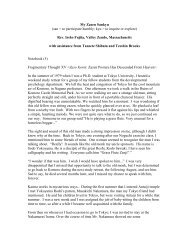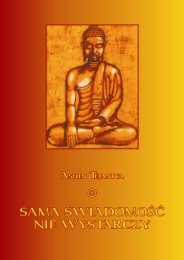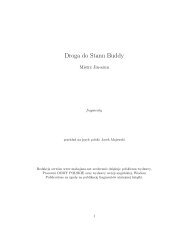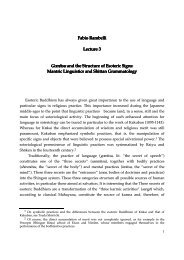Mahamudra Teaching - Dharma Media
Mahamudra Teaching - Dharma Media
Mahamudra Teaching - Dharma Media
Create successful ePaper yourself
Turn your PDF publications into a flip-book with our unique Google optimized e-Paper software.
In the beginning, when you do this meditation, particularly when your mind is busy, it is better to<br />
gaze the eyes downwards. Gaze in the general direction of the tip of the nose, not looking too closely<br />
or too far away. Then if you are getting a little sleepy or feel like you are “sinking,” gaze upwards a<br />
little. This helps to uplift the mind. Then apply this kind of mindfulness practice not only during the<br />
sitting session time but also when you walk, when you sit, when you jog, when you eat, at any kind<br />
of place or time. Your mind is always with you; maintain it in a relaxed manner. Then do all different<br />
activities mindfully, with awareness, and with relaxed state. Tilopa said, “Use many different<br />
methods to relax your mind, to bring your mind to the right place, not just one.” Sometimes you need<br />
to reflect on impermanence, sometimes you may need to reflect on the suffering of samsara or on<br />
cause and effect, or maybe you need to reflect on the essenceless of mind or on how precious the<br />
<strong>Dharma</strong> is. Use all these different methods to bring your mind to the right place. So the emphasis<br />
should all be placed on how to bring the mind to the right place. This is very, very important.<br />
Naropa got a “special method” teaching from Tilopa called “way of kind of holding the mind”<br />
method. It is like a chain, very, very complex. Apparently Naropa’s mind was so wild! In order to<br />
tame it and bring it to the right place, there’s a special method called “metal-like chain” which is put<br />
together in a very complex way!<br />
So you should practice this calmly abiding meditation or shamatha until the time comes when you<br />
feel so comfortable with your meditation and you can set your mind in the right place very easily. Or,<br />
if you release that meditation, that also takes place very easily. Sometimes when you have such a<br />
meditation [Khenpo: Maybe a few, not many people maybe!], when you get such a state of calmly<br />
abiding meditation, then you feel so blissful. You feel such a peace and harmony, and sometimes you<br />
attach to that. One thinks, “Oh, I don’t want to get out of this, I just want to stay there.” That also is<br />
not right either. It is not right for the special insight. This kind of shamatha is very good, but if you<br />
are attached, then you cannot actualize the special insight. If that happens then you just have to break<br />
that attachment. A sign of having this happen is that when one achieves it, it is very easy to meditate,<br />
but very difficult to come out of the meditation. [Khenpo: For us maybe there is no problem with<br />
that!] Anyway, with support meditation you just have to achieve a supple state of mind. Mind<br />
becomes so flexible. When you meditate, you can meditate. When you get out of that, then you can<br />
get out of it. This is what you need to achieve. After that, then you can start shamatha or calmly<br />
abiding meditation without support.<br />
Shamatha, Calmly Abiding, Without Support<br />
So when one achieves this supple state of mind by applying meditation with support, then one can<br />
start with the calmly abiding meditation without support. To do so assume a bodily posture, as<br />
described earlier, in a relaxed state. Then when we do this meditation, here in the West we often have<br />
all of the things we need. In contrast, in the Himalayan Mountains when you get cold, the upper part<br />
of the body is cooler, fresh, while we may have warmer clothes on the lower part of the body. In the<br />
West you can use a heater, isn’t it that so? When you get cold, there is a heater. When you get hot,<br />
then you use air conditioning. So usually, when it is a little bit cooler, that is good. When we get<br />
warmer we get sluggish, we “sink,” a little more lethargy rises, things seem a little unclear. Then<br />
before long we are ready to go to sleep. So these are some of the obstacles for the calmly abiding<br />
meditation. So you can look a little more alertly with your eyes. You can be a little tenser, a little more<br />
alert. In this case, basically, your mind should be a little more alert or tense.



![Shushogi, Dogen Zenji [PDF] - Mahajana.net](https://img.yumpu.com/50921105/1/190x219/shushogi-dogen-zenji-pdf-mahajananet.jpg?quality=85)


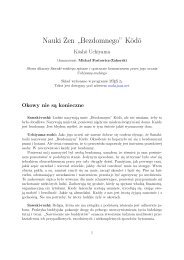

![wywiadu z Murakami Kosho Roshim [PDF] - Buddyzm w Polsce i na ...](https://img.yumpu.com/45809746/1/184x260/wywiadu-z-murakami-kosho-roshim-pdf-buddyzm-w-polsce-i-na-.jpg?quality=85)



